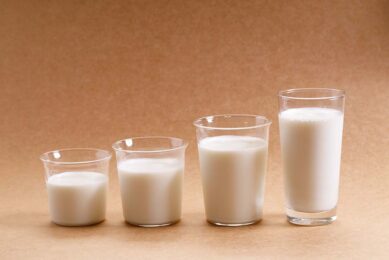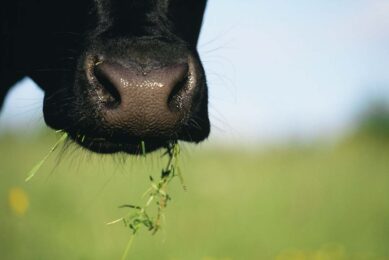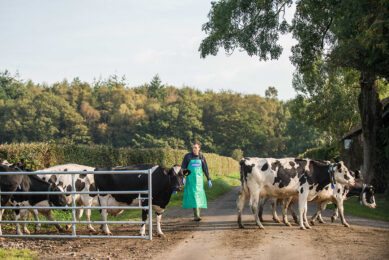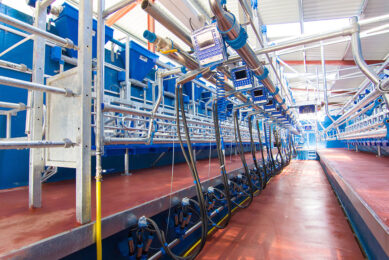Väätsa farm opts for further growth
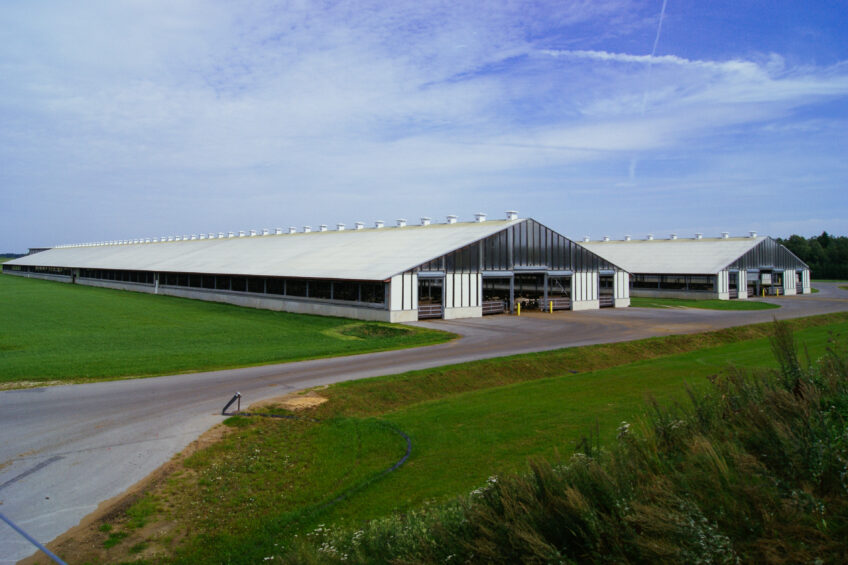
Estonian dairy giant Trigon Dairy Farming Estonia has sufficient, affordable, land and a big enough milking parlour to place a third barn to add another 1,100 dairy cows. “But money has to come from investors, not the bank,” says general manager Margus Muld.
Trigon Dairy Farming Estonia (TDFE) owns three dairy farms in Estonia. One of these farms is located in Väätsa, about one hour drive from the Estonian capital Tallinn. The farm was acquired in 2012 and with an injection of €11 million, this farm has been turned into a modern and cost-efficient farm in just over ten months. The other Trigon farms are located in Kaiu (at 35km) and Karla (at 250km). In total, the company milks a herd of 3,600 Holstein milking cows plus youngstock,” explains Margus Muld, general manager of TDFE.

Large savings due to re-use of heat
While visiting the farm in Väätsa, the largest of the three farms with a herd of 2,250 dairy cows plus youngstock, the first thing that is noticed is the spacious set up of the barns, silage bunks, a large office building and the endless hectares of cropland surrounding the farm. There are two cow barns, each housing 1,100 cows and stretching 250 metres long. The houses are designs with three rows, the feeding area (near the aisle), the drinking area in the middle and the resting area at the back. The farm manager believes that this barn design favours the eating behaviour of the animals, hence having a positive effect on production and health. A plot of land is already reserved for building another – same size – barn next to the two current ones. The Väätsa farm is equipped with a rotary milk parlour from DeLaval, suited to milk 80 cows in one go. It runs 24/7. With this parlour, a total of 400-450 cows are milked per hour, and with only three people in the parlour this is quite efficient. The employees work in shifts and altogether, the 2,000 lactating cows enter the milking parlour three times per day. The waiting area of the milking parlour has an automatic flushing system that keeps the floors clean. Rain water is collected in the gutters, located between the farms, and small pumps bring this water to the waiting area and release this from a valve in the floor. This system is commonly used in the US as well.

Profile
Name: Margus Muld (42)
Place: Väätsa, Estonia
Company: The farm, part of Trigon Dairy Farming Estonia, has 2,200 dairy cows.
Land: Total 4,000 ha – 1,701 ha are cereal land, of which 263 ha spring rapeseed, 228 ha winter triticale, 67 ha winter wheat, 444 ha spring wheat and 699 ha oats. Production grains totalled 6,295 tonnes in 2016. Trigon Dairy Farming Estonia is an Estonian company, founded in 2006. With 3 dairy farms and a total herd of 7,000 dairy animals, of which 3,550 milking cows, it is the biggest dairy operation of the Baltics. All efforts are focused on further upscaling to increase cost-efficiency. The farm in Väätsa is planned to be upgraded with another barn for 1,100 cows in the near future.
The large volume of milk collected each day has to be cooled down from an estimate 35°C to 4-5°C. But this has an extra benefit that the farm uses in a savvy way. Muld explains: “We don’t have a normal heating system at the farm as we use the heat, generated from cooling down the milk, to heat the whole farm by using the energy to heat water. This saves us a whopping €40,000-50,000 per year”. The amount of heat generated is sufficient to warm up the milking parlour, rest rooms and office building barns throughout the whole year, also in extreme winter colds. Temperatures can drop to 25-30°C below zero. However, this extreme cold only lasts a couple of weeks per year. When the temperature in the barns drop below 21°C, curtains at the side of the barns automatically close and vice versa.

The modern barn and milking equipment, combined with dedicated staff and focused management, has led to increased milk yields over the last few years. In Väätsa, milk production has been increased from 9,500kg per cow per year in 2014 to 11,100kg in 2016. Projected milk production for 2017 is even higher again: 11,300kg. Väätsa’s production levels are behind the ones at the Kaiu location, where production is expected to reach a whopping 12,200 kg per cow in 2017. The farm located in Karla will reach 10,800kg per cow this year. In total, in Väätsa alone, the milk output will reach 25,486 tonnes in 2017, of which 24,749 tonnes sold to processors. The milk is sold to different processors. This way, Muld wants to spread the risks and make separate agreements with each of the processors, and because the company is leading in Estonia, the agreements made are quite good. Milk is now sold to the companies Valio Eesti and Estover piimatööstus OÜ.

Focus on cow health
“Our production levels are around 25% higher than the Estonian average (8,900 kg per cow per year). This is because we profit from our farm size, we have a focused management, we have in-house staff of milkers, veterinarians, inseminators and field workers (in total 85 employees, including management) and the land is still affordable in Estonia,” explains Muld. The price for a hectare of land ranges from €3,500-4,000. This is far less than what needs to be paid for land in Scandinavian countries or the Netherlands for example. But keeping milk levels high requires optimum management and animal health. Managing hoof health is challenging, especially in large farms. Muld says: “Our cows have to walk relatively long distances. From the barn to the milking parlour three times a day, and around the barn itself. Hoof trimming (at least three times a year) and treatment is therefore key for us. Trimming is not the silver bullet, but it is a tool to keep it under control.” The farm only uses Holsteins and the inseminator, who has been working at the farm since the beginning, performs between 5,000-6,000 inseminations per year. Muld adds, “We use sexed semen for the heifers only. This results in a 57% female rate of calves. The bull calves (around 1,200 per year) are sold to the Netherlands for veal calf production, a sector that doesn’t exist in Estonia. Although the barns for the dairy farms are new, the calves are still housed in one of the old buildings. “At some days, we have up to 35 newborn calves coming in this barn. For the first four weeks they are housed in single crates and fed twice a day. Then they move to group housing, in pens of ten calves,” says Muld.

Organic manure looked into
Not only is the milk production higher than the domestic average, also the cereal yields are on average 20% above the Estonian average harvest volume. Part of it is mixed in the TMR for the cows. The farm feeds 40,000 tons of silage and 5,500 tons of cereals each year. Corn and the vitamin and mineral premix are purchased from other companies. No extra feed additives are added to the feed. “We produce a lot of cereals but haven’t reached the full potential here. We don’t use artificial fertilisers. We are planning some trials with this, to see how far we can stretch the extra output if we apply an NPK solution in a balanced way,” says Muld. Last season, 5,700 tonnes of cereals were harvested. The amount of land available is ideal to get rid of 130-140,000 tons of manure per year produced at the farm. The farm is set up with two large manure lagoons, situated behind the cow barns. The €11 million investment of the farm also included the installation of a manure separation and composter. In a separate machine room next to it, three separators and a composter for bedding can be found. Two of the three separators produce a solid part with a dry matter content of 28%, which is applied directly on the land. One separator produces a solid part of 32% dry matter, which goes through a composter for bedding. The composter produces 200kg of composted material per hour. Inside, the temperature is increased to 65 degrees as a result of bacterial activity and in such high temperatures most of the pathogenic bacteria are killed. Muld and his team are also interested to see whether they can produce organic manure, to be able to produce organic cereals. “When calves are housed outside on pasture, the manure can be sold and used as organic manure. But the rules are not clarified on this topic, so we are waiting for more information on the exact criteria to be able to label manure as organic manure. Organic oats for example are far more profitable (€300 per hectare) than conventional grown oats (€120 per hectare). It is an interesting area to look into,” says Muld.

Growth without extra loans
In the dairy business, due to the many investments to modernise the farms and the aftermath of the dairy crisis, the loans have been increased. Nevertheless, the dairy farming business is looking better, especially because the farm has a cost-efficient way of producing and also aims to expand the dairy herd (in Väätsa from 2,250 to 3,300 cows). Muld: “We are planning to expand the farm with another barn, equipped for another 1,100 cows. In practice this will mean we only need to hire an extra five people. This is why size makes the farm so cost-efficient. We don’t need a lot of extra people when we expand, probably only five,” according to Muld. It is all about making dairy production as efficient as possible and upscaling is an important factor do be able to reach this. The milk price is good (around €0.32).” However, the Swedish bank loans are not endless and the expansions and other investments of the dairy farms need to come from other investors. “We are in the process of planning a public offering to raise capital. We don’t want to increase our leverage even further. Although we are highly profitable this year, our net debt is still €10.5 million and we don’t want make expansions purely on debt finance. Also interest rates will keep on rising,” explains Muld. TDFE total revenue in 2017 is expected to be over €21 million, which will bring the EBITDA to over €5 million.

Not only dependent on milk
As dairy farming will remain a significant part of the business of Trigon Agri Managers, the management company running TDFE, the owners are also looking to invest their money in other activities, such as technological farming projects in vegetables (using LED lighting and vertical farming for example) or hydroponics; types of agricultural production that are not depended on seasons. The company is also looking to explore the possibilities in the production of new protein sources. “Having large scale – industrial – dairy production also means you have to farm in a sustainable way. We recycle heat and water for example, but we see cost-efficient production also as a big driver for sustainability. We are also not afraid of EU rules on agriculture and environment becoming stricter. It will mean you have to innovate and stay ahead of the game,” explains Muld. Dairy farming definitely has room to grow further in Estonia and the future looks bright for the Väätsa farm. Nevertheless, dairy production is still a volatile and unpredictable market. So the future plans of Trigon Agri to add more agricultural activities to their dairy and cereal business might not be such as bad idea. It will prevent that income is solely dependent on milk prices. “But we will not produce more tomatoes than milk in the future, don’t worry. Dairy farming has still so much potential in Estonia and our cereal business is on stand-by for times when milk prices drop,” concludes Muld.
Join 13,000+ subscribers
Subscribe to our newsletter to stay updated about all the need-to-know content in the dairy sector, two times a week.



